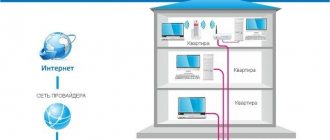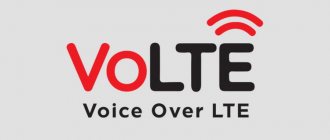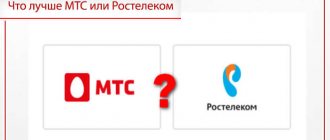Over the past 5 years, wireless data transmission technologies have made huge strides forward. If a couple of years ago everyone was content with the third generation network and only in large cities the 4G network was well distributed, but today high-speed Internet for phones and tablets is available throughout most of central Russia. Tariffs supporting this technology are offered to their customers by all major operators: MTS, Beeline, Megafon, Yota and Tele2. In this article you will find out the answers to all your questions about LTE and 4G - are they the same thing or not, how to distinguish between them and what to choose. First you need to understand the terminology and understand what each type of data transfer is individually.
Why are 4G and LTE two different technologies?
You probably notice that the Long Term Advanced prefix is constantly used in the description of smartphones/tablets with fourth-generation network support. The same applies to operators. Companies indicate 4G LTE in all names and characteristics. Because of this, users and clients have the impression that they are one and the same. Phone manufacturers and providers do not focus on similarities and differences. In fact, there is no deception on the part of the companies in this. Using the two concepts together is only necessary to attract buyers. On the one hand, 4G and LTE belong to the same generation, on the other hand, they have several differences that every user should know. Let's start by defining these two concepts and see what the difference is between them.
By the way, we should soon expect the spread of 5G networks, a new generation standard. Already, all major players in the mobile communications market are actively working on the development of this technology.
What's the difference
Despite belonging to the same order, the 4G network differs from LTE in several significant criteria. Let's look at them in detail.
Technologies and operating principles
Today, the communication standards described are promoted as similar. Although their very origin suggests otherwise.
When 4G technology was just being introduced, it was stated that the speed of information dissemination would be in the range from 100 Mbit/s to 1 Gbit/s. These values were amazing at that time, but the process of achieving them turned out to be longer than expected.
The 4G network was the first to use VoIP technology, thanks to which voice communication became part of the overall transmission of information. As a result, not only the speed of the Internet connection has increased, but also the cost of voice messages has become cheaper.
4G technology continues to develop, but the intermediate LTE network has not yet reached the coveted 100 Mbit/s. But this did not prevent its popularization, because users receive a stable connection.
Technically, it is more correct to refer to the 4th generation network not as LTE, but as LTE-Advanced. This is an optimized technology that, when tested, shows speeds of up to 300 Mbps.
LTE-Advanced is better than the standard version not only in terms of speed, it can operate with several carrier frequencies at once. This makes the Internet connection high quality regardless of the number of users. And the standard LTE network is technically more of an optimized version of 3G. In terms of speed indicators, it is closer to the 3rd generation.
Bandwidth
The LTE network operates using GSM/EDGE and UMTS/HSPA wireless information transmission technologies. Compared to 3G, they provide increased throughput, but rarely reaching 100 Mbit/s. The improved performance is due to the introduction of an updated access mode and network core. But, when compared with the 4th generation, the throughput does not reach it.
In a 4G network, the throughput exceeds 100 Mbit/s for mobile devices and reaches as much as 1 Gbit/s for stationary equipment.
Coverage area
There are still problems with this. In our country, mobile operators provide wide coverage only for the 3G network. In our country, both 4G and LTE are at the stage of development and advancement, so there is no need to talk about high-quality coverage yet. The number of 4th generation communication stations is growing, but an Internet connection of acceptable quality is not always available.
4th generation network coverage is concentrated in the central regions of the country, gradually covering the southern and Ural territories. But the LTE-Advanced network so far operates only in large populated areas.
Comfort of use
Both networks are equally convenient. The only problem is that the 4th generation is not supported everywhere and not by all devices. Operators are interested in switching users to 4G; often, to gain access it is enough to change the SIM card. When purchasing a smartphone, it is important to pay attention to the presence of an LTE label on at least one SIM card slot.
Speed comparison
4G communication is faster than LTE. The standard LTE network provides information sending speeds of about 10 Mbit/s, and the optimized LTE-Advanced network provides up to 60 Mbit/s. The information reception speed is up to 30 Mbit/s for a standard LTE network, and up to 50 Mbit/s for an optimized one.
The difference in speeds between 4G and 3G is noticeable. If the first network shows a result of 100 Mbit/s, then when using a 3rd generation network the speed rarely reaches 5 Mbit/s. That's why users get the feeling that LTE is closer to 4G than to 3G.
When a smartphone has poor signal reception, the H+ symbol often appears instead of 4G. It means a transition to the 3rd generation HSRA+ network.
The LTE network is characterized by a short ping - the time during which a request is transmitted to another device and returned back. Such conditions are sufficient to perform most common tasks on the Internet, including watching movies online in high definition, communicating via audio and video. That is, when communicating on Skype, the interlocutors are confident that they can hear each other correctly, without delays.
What is 4G?
The abbreviation stands for 4generation, that is, the fourth generation. In 2008, this standard was recognized by the convention on the development of wireless technologies in Geneva. The maximum promised throughput of this type of communication is 1Gb/s (for landline subscribers) and 100Mb/s (for mobile subscribers). The fourth generation includes two types of wireless Internet technologies - LTE and WiMAX 2. However, the first appearance of the technology among the masses did not satisfy the creators and users, because the speed differed significantly from the declared maximum for the worse. However, under the influence of marketing and the need to promote the new product to the masses, the technology was sold under the guise of full-fledged 4G.
To understand the difference between LTE and 4G, you need to know that LTE is an intermediate stage in the development of wireless communications. The full-fledged 4G generation appeared with the release of the so-called 4G+ or LTE Advanced, which is served under the shell of an “overclocked” Internet. But in fact, this is exactly the speed that the regular 4G standard should show. And this is far from the ceiling for the fourth generation of wireless network. On our website you can read educational material about how 4G Internet differs from 4G+.
What other types of technology exist?
Lately, more and more users have been wondering what LTE-Advanced is. This is a type of LTE, which in its technical parameters has a lot in common with 4G. The technology was officially recognized by the International Telecommunication Union in 2012. The results of the tests showed that LTE Advanced meets all 4G requirements, including speed indicators.
Cellular - what is it on iPad, what is the difference
Communication in devices connected to LTE-A can only theoretically reach the required speed levels of 100 Mb/s in dynamics and 1 Gb/s in static. But this does not negate the fact that this technology is the advanced standard of the fourth generation of mobile Internet.
For your information! There are few differences between LTE-A and just LTE. The main feature of the more advanced version is the aggregation of carrier frequency ranges, that is, the simultaneous (parallel) use of several frequencies. Thanks to this feature, it is possible to increase the data transfer speed.
Results of testing LTE Advanced mobile technology for speed
Mobile Internet is in great demand because it allows you to have high-speed Internet access at a convenient time and almost anywhere. Moreover, it does not matter whether the receiving side is in a static position or dynamic. Perhaps the only disadvantage of using mobile Internet in Russia is its high cost.
What is LTE?
Now let's look at LTE as a separate type of data transmission over the air. The abbreviation stands for Long Term Evolution, which translates as long-term development. LTE is the first stage in the development of 4G at the very beginning of its appearance. The characteristics and capabilities of this network do not meet the requirements of the International Telecommunication Union, however, to attract people, manufacturers use LTE under the guise of full-fledged 4G. Over time, the union approved the use of these two concepts in one label, which is why it exists to this day.
When technologies make it possible to achieve the stated speeds, operators began to offer full 4G (or as the ITU called it - True 4G) for 4G+ or Advanced. Now you know the main difference between 4G and LTE. Also on our website you can find out the main differences between 5G and 4G!
HSPA+ technology can compare in parameters with LTE. Many people probably notice that sometimes when the signal is bad, the H+ icon appears. This type of wireless connection belongs to the third generation (3G) and offers more modest data transfer speeds.
Which is better: 4g or LTE?
If you compare speeds, the answer will be obvious. However, the differences between LTE and 4g lie not only in speed, but also in coverage area. This issue is especially acute in Russia, where the coverage of the territory with this technology is no more than 50% of the entire country. On our information portal you can look at a map with the 4g LTE coverage area in Russia and evaluate in which regions you can safely use high-speed Internet.
If the regular 4G standard is gradually moving from the central part towards the Urals and to the south of the country, the “overclocked” Advanced version is now available only in large cities and the capital. In addition, the new standard with higher speeds is currently provided by only two Russian operators - Beeline and Megafon.
The second problem is the need for an appropriate device. In most cases, the reason for low speed is not only network failures, but also weak user devices that do not allow the technology to prove itself.
You must select LTE or 4g from the parameters described above. Most users are satisfied with LTE 4G capabilities. Until Advanced becomes widespread, which will be comparable to 4G, it makes no sense to switch to it.
Now you know how 4g differs from LTE in a phone and you can make a choice based on your needs and capabilities. Read on our information portal about what LTE TDD and FDD are, as well as a lot of useful material on choosing an operator and coverage area.
Packet switching and circuit switching
The benefits of a circuit-switched network include faster connection times and less chance of connection drops. The new networks use packet switching technology, a modern protocol that uses many more connected points around the world. In a packet switched network, your information is broken down into small pieces that are then sent to your destination. If a node drops from your connection in circuit-switched networks, then you will have to reconnect, but in a packet-switched network, the next packet simply finds a different path.
Many of the technologies used to create 4G speeds have nothing to do with voice communications. Because voice networks still use circuit switching technology, there has been a need to reconcile the differences between older and newer network structures.
Carriers are already testing the fifth generation of 5G mobile broadband connections, but much remains to be resolved. There is no agreed standard yet, and we are unlikely to see 5G launch until 2020.











